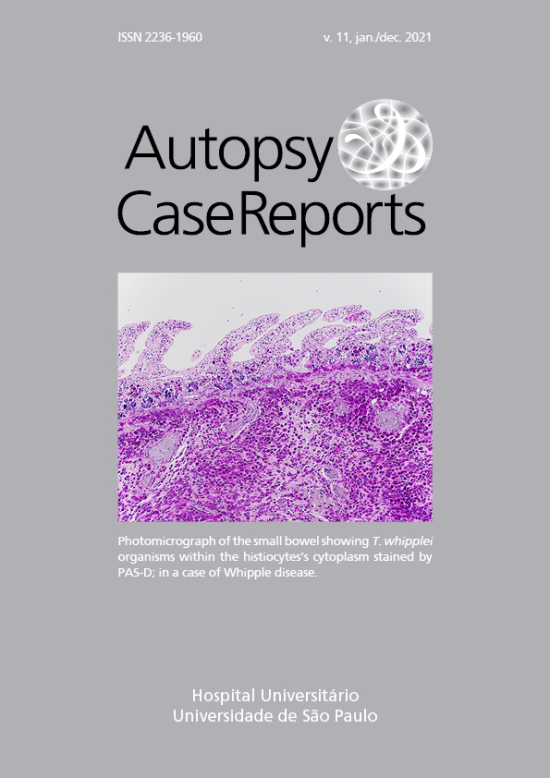Pseudomonas aeruginosa necrotizing bronchopneumonia
DOI:
https://doi.org/10.4322/acr.2021.271Keywords:
Pseudomonas aeruginosa, Bronchopneumonia, Infant, Premature, Low Birth Weight, Neonatal Sepsis, Cross InfectionAbstract
Extremely low birth weight (ELBW) infants are at particularly high risk for infection due to an immature immune system, invasive procedures such as endotracheal intubation, intravascular catheterization, and other factors. Neonatal infections in this population are associated with a high mortality, poor growth, and neurodevelopmental outcomes. Pseudomonas aeruginosa (P. aeruginosa) infection is an uncommon but potentially devastating cause of pneumonia and sepsis in the ELBW population. P. aeruginosa is an important cause of healthcare-associated infections (HAI) or nosocomial infections. P. aeruginosa can perceive unfavorable environmental changes and orchestrate adaptations by developing plasmid-mediated and adaptive resistance to antibiotics. We describe an ELBW infant born at 26 weeks’ gestation who succumbed at 13 days of life to P. aeruginosa infection. Some of the factors related to the pathogenesis and multidrug resistance are described.
Downloads
References
Kylat RI, Ohlsson A. Recombinant human activated protein C for severe sepsis in neonates. Cochrane Database Syst Rev. 2012;2012(4):CD005385. http://dx.doi.org/10.1002/14651858.CD005385.pub3. PMid:22513930.
Nizet V, Klein JO. Bacterial sepsis and meningitis. In: Wilson CB, Nizet V, Maldonado YA, Remington JS, Klein JO, editors. Remington and Klein's infectious diseases of the fetus and newborn infant. 8th ed. Philadephia: Elsevier; 2016. p. 217-71.
Shane AL, Sánchez PJ, Stoll BJ. Neonatal sepsis. Lancet. 2017;390(10104):1770-80. http://dx.doi.org/10.1016/S0140-6736(17)31002-4. PMid:28434651.
Wu W, Jin Y, Bai F, Jin S. Pseudomonas aeruginosa. In: Tang Y, Sussman M, Liu D, Poxton I, Schwartzman J, editors. Molecular medical microbiology. 2nd ed. Waltham, MA: Elsevier; 2015. p. 753-68.
Ardua MI, Leber A. Pseudomonas and related genera. In: Cherry JD, Demmler-Harrison GJ, Kaplan SL, Steinbach WJ, Hotez PJ, editors. Feigin and Cherry’s textbook of pediatric infectious diseases. 8th ed. Philadelphia: Elsevier; 2019. p. 1135-11.
Rosenthal VD, Bat-Erdene I, Gupta D, et al. International Nosocomial Infection Control Consortium (INICC) report, data summary of 45 countries for 2012-2017: device-associated module. Am J Infect Control. 2020;48(4):423-32. http://dx.doi.org/10.1016/j.ajic.2019.08.023. PMid:31676155.
Centers for Disease Control and Prevention (CDC). Antibiotic resistance threats report. Atlanta; 2019 [cited 2020 Aug 23]. Available from:
Jernigan JA, Hatfield KM, Wolford H, et al. Multidrug-resistant bacterial infections in U.S. hospitalized patients, 2012-2017. N Engl J Med. 2020;382(14):1309-19. http://dx.doi.org/10.1056/NEJMoa1914433. PMid:32242356.
Esper F. Postnatal bacterial infections. In Martin RJ, Fanaroff AA, Walsh MC, editors. Fanaroff and Martin’s neonatal-perinatal medicine. 11th ed. Philadelphia: Elsevier; 2020. p. 789-808.
Greenberg RG, Kandefer S, Do BT, et al. Late-onset sepsis in extremely premature infants: 2000-2011. Pediatr Infect Dis J. 2017;36(8):774-9. http://dx.doi.org/10.1097/INF.0000000000001570. PMid:28709162.
Maurice NM, Bedi B, Sadikot RT. Pseudomonas aeruginosa biofilms: host response and clinical implications in lung infections. Am J Respir Cell Mol Biol. 2018;58(4):428-39. http://dx.doi.org/10.1165/rcmb.2017-0321TR. PMid:29372812.
Fujitani S, Sun HY, Yu VL, Weingarten JA. Pneumonia due to Pseudomonas aeruginosa: part I: epidemiology, clinical diagnosis, and source. Chest. 2011;139(4):909-19. http://dx.doi.org/10.1378/chest.10-0166. PMid:21467058.
Sun HY, Fujitani S, Quintiliani R, Yu VL. Pneumonia due to Pseudomonas aeruginosa: part II: antimicrobial resistance, pharmacodynamic concepts, and antibiotic therapy. Chest. 2011;139(5):1172-85. http://dx.doi.org/10.1378/chest.10-0167. PMid:21540216.
Morello E, Pérez-Berezo T, Boisseau C, et al. Pseudomonas aeruginosa lipoxygenase LoxA contributes to lung infection by altering the host immune lipid signaling. Front Microbiol. 2019;10:1826. http://dx.doi.org/10.3389/fmicb.2019.01826. PMid:31474948.
Moradali MF, Ghods S, Rehm BH. Pseudomonas aeruginosa lifestyle: a paradigm for adaptation, survival, and persistence. Front Cell Infect Microbiol. 2017;7:39.; published online February 15, 2017. http://dx.doi.org/10.3389/fcimb.2017.00039. PMid:28261568.
O’Donnell JN, Rhodes NJ, Lopez J, Jett R, Scheetz MH. Carbapenems vs. alternative β-lactams for the treatment of nosocomial pneumonia: A systematic review and meta-analysis. Int J Antimicrob Agents. 2018;52(4):451-8. http://dx.doi.org/10.1016/j.ijantimicag.2018.04.011. PMid:29665442.
Crandon JL, Luyt CE, Aubry A, Chastre J, Nicolau DP. Pharmacodynamics of carbapenems for the treatment of Pseudomonas aeruginosa ventilator-associated pneumonia: associations with clinical outcome and recurrence. J Antimicrob Chemother. 2016;71(9):2534-7. http://dx.doi.org/10.1093/jac/dkw200. PMid:27272723.
Downloads
Published
Issue
Section
License
Copyright (c) 2021 Autopsy and Case Reports

This work is licensed under a Creative Commons Attribution 4.0 International License.
Copyright
Authors of articles published by Autopsy and Case Report retain the copyright of their work without restrictions, licensing it under the Creative Commons Attribution License - CC-BY, which allows articles to be re-used and re-distributed without restriction, as long as the original work is correctly cited.



